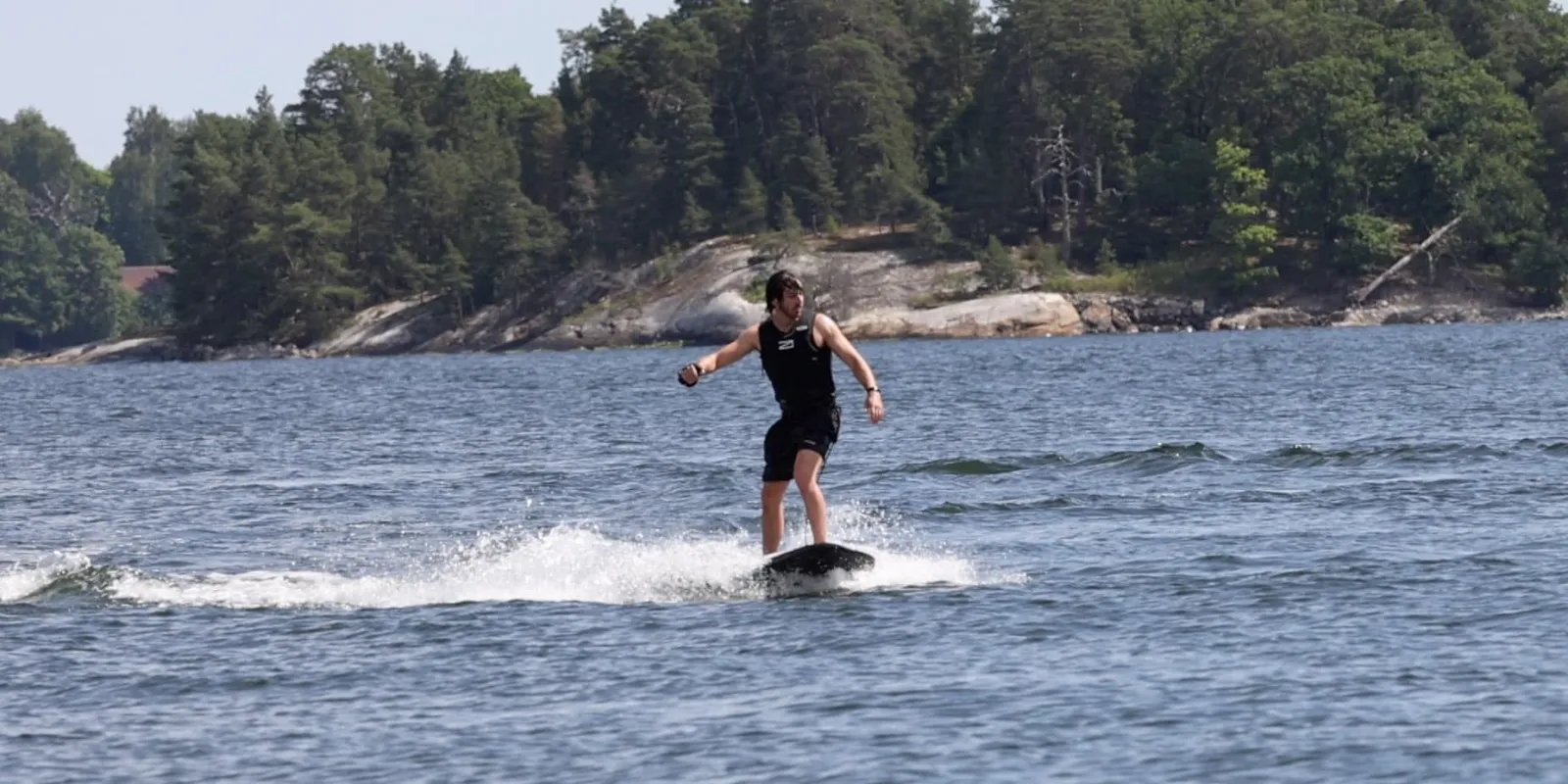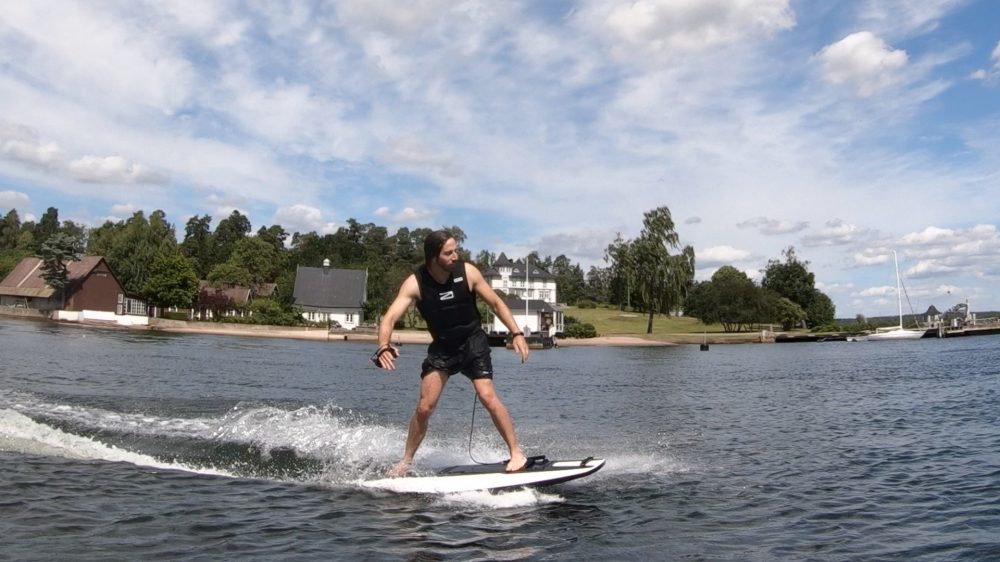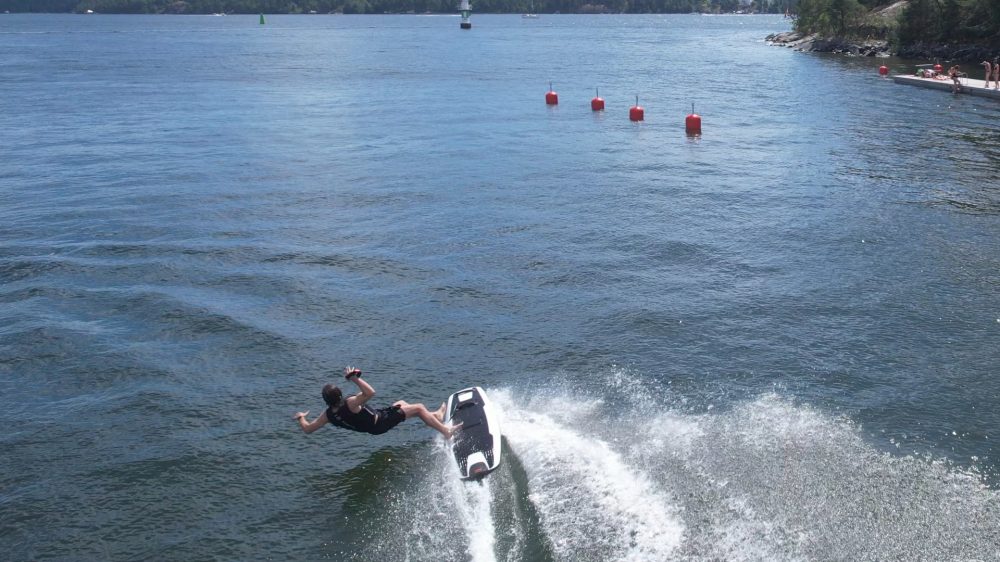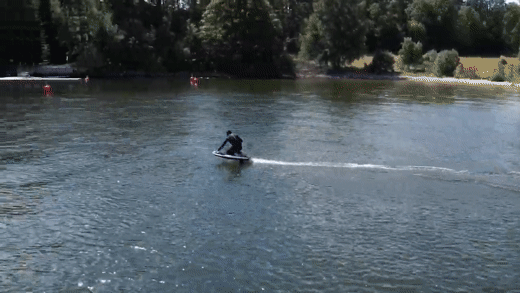
It was a beautiful morning in Stockholm when I rolled up on a sandy beach, ready for my first electric surfboard experience in two years. I’m not a complete beginner at e-surfboards, but my couple of sessions over the last few years don’t exactly make me a seasoned professional either. Even so, I was excited to test out some of the most high-performance electric surfboards in existence: Awake’s RÄVIK boards.
Nothing was going to dampen my excitement, not even the frigid Stockholm water. But I had time to mentally and physically prepare myself for that shock, as the first item on the agenda was familiarizing myself with what the hell these glossy black rockets were before me.
That job fell on Flo, Awake’s professional rider and someone who I’m quite certain was born on a surfboard.
Flo walked my wife and me through the controls and demonstrated how we were supposed ride the board. Lay on your stomach, connect the kill switch, give the wireless controller some throttle, and then rise to your knees, followed by your feet.
Simple. Right?
The only thing left to do was to do it. I suited up in the coolest life jacket I’ve ever worn and felt the shock of the freezing water as we strode into the slight surf kicked up by the breeze and passing motorboats.
To see if I failed or succeeded in full life color, check out the video below of my day on Awake’s electric surfboards. Then keep reading below for the full details. Or you can be boring and skip the video, but that just doesn’t sound like you.
At this point I was happy to have had even a couple days of experience on electric surfboards under my belt. I didn’t remember much, but what I did remember was important. The best piece of advice I can give you is to have a steady trigger finger and just go for it. Steady power delivery is key.
I started on my stomach, laying on the RÄVIK 3 board while holding the front grab handle in my left hand and the trigger throttle in my right hand. The RÄVIK 3 is the more beginner friendly of the lineup of three boards. It’s still a beast that can get you up to 31 knots (37 mph or 57 km/h), but it’s a bit wider and more stable than Awake’s other boards, making it easier to get started.
The profile on the bottom keeps it nice and agile though, especially compared to other larger and heavier electric surfboard brands out there.

So anyways, where was I? Oh right, trying to surf. So I started out zooming around on my stomach to get a feel for the board. At least that’s what I told the Awake folks I was doing. “I just want to get a feel for the controls.”
What I meant was “I’m gonna need a second to mentally prepare myself for probably looking like an idiot as soon as I stand up on this thing and get tossed into another dimension.”
But once I felt confident enough to give it a shot, which was once I was far enough from shore that no one would hear my gurgle scream upon wiping out, I gave it a shot.
I hopped up onto my knees, then quickly afterward committed by standing up as tall as I shakily could. And the weirdest thing happened: It worked! I was surfing!

I don’t know if I was drawing upon my electric skateboard experience, if the board’s profile just made it easy for beginners, or if I was just getting lucky. But lo and behold, I was flying across the surface of the water without making a fool of myself! I even looked almost like I knew what I was doing. Almost.
The fact that Flo was wise enough to start me out in the board’s Eco mode might have helped, but he soon switched me over into Sport mode after I proved that I wasn’t a danger to myself or others.
The more I rode the RÄVIK 3, the more comfortable I got pushing it harder. And yes, I definitely wiped out a few times, but the wipeouts were fewer and farther between than I expected. It’s also a humbling experience to be boastfully flashing the “hang loose” sign and then going for a 20 mph dunk in an ice bath.
But as shocking as it was, a water landing is a much nicer exit strategy than any other crash I’ve experienced.

And because of that, I felt much more confident pushing it harder than on any other electric rideable I’ve tried. I love my e-bikes and e-motorcycles and e-skateboards, etc. But I’m also fairly conservative and don’t push the limit too terribly far. I’m not usually found dragging knee in corners or using every last millimeter of the sides of my tires.
And the reason is that the cost of failure is just too high. When I corner hard on my electric skateboards, I never quite know where the limit is, and that always makes me a bit uncomfortable.
On the RÄVIK 3, I still don’t know where the limit is when I push it hard, but it also just doesn’t matter as much. A few times I definitely got a bit big for my britches and took some turns way too sharp. I didn’t have the skill to react as quickly as I needed to when I hit some waves and I left the board in a semi-violent rag doll motion.
I hit the drink, bobbed to the surface, spit out a mouthful of water, and did the paddle of shame back to the board. That was it. No road rash. No brain damage. No scars. You can crash as much as you want and you’ll just get wetter. It’s an awesome way to progress without the danger or pain.

In fact, speaking of progression, that’s what I felt like I was doing. It didn’t feel like I was playing with a toy. It felt like I was progressing at learning a new sport.
Sure, these will be used as toys by many rich yacht owners, but they’re also opening up a whole new segment of adventure sports, and I can see why.
They’re fun, challenging, and rewarding all at once.
Watching Flo jump a meter in the air while on the boards showed that an experienced surfer can really push the limits of the boards, making this a true action sport.
Flo even felt I was doing well enough on the RÄVIK 3 that it was time for me to give his RÄVIK S a try. The RÄVIK S is the flagship model in Awake’s lineup. The narrower design makes it even more quick and agile, while the contours on the bottom of the board help you cut hard across the water. It also has optional foot straps that can help you take your surfing to the next level, leaning more aggressively and performing jumps that require the board to stay with you.
Flo can fly through the air like a bird on the Ravik S. I… couldn’t do that.
Perhaps I could one day, but first I’d have re-learn how to get up. The RÄVIK S was much harder for me to get started on. I could get moving, but standing up and somehow quickly shoving my feet into the foot straps was tricky, to say the least. You’re on a wet, unstable platform that is bouncing around as you try to precisely land your only balance sticks into a very precise pocket. It’s not an easy thing to do for a beginner, as I intimately discovered. I could sort of get up for a bit, but I kept focusing too hard on wiggling my feet into the straps one at a time and would inevitably lose my balance during that operation and wipeout. The agility of the board makes it a bit harder to get started until you get used to it. I definitely missed the stability of the RÄVIK 3.
The Awake team said in hindsight that it probably would have been better for me to start with a single foot strap while riding the RÄVIK S, get used to that, and then add the second foot strap. Welp, maybe next time. This time I didn’t have a chance to try that because I had bigger fish to fry. Or taller fish, in the form of the Awake VINGA.

The Vinga is the company’s third board and features a hydrofoil that lets you fly nearly a meter above the water in an ultra sleek and ultra efficient way. Flo said you can actually get up to two hours of ride time while foiling, that’s how efficient it is. For comparison, most people will get closer to an hour on the RÄVIK 3, maybe less if you’re pushing it super hard and not falling much. For what its worth, I did perhaps 30-45 minutes on one of the RÄVIK 3 boards and didn’t even use half the battery, but I was also occasionally taking breaks to smash my face into the water, which seems to help get more run time.
The VINGA is definitely in a different category, but that also makes it a bit harder to get the hang of since it has its own dynamic. As you pick up speed, you start rising out of the water and you have to control the height yourself based on fine-tuned adjustments to the weight distribution in your front and back feet.
I’m a bit spoiled by testing Candela’s electric hydrofoil boats that use computers to control the hydrofoiling for you. With a hydrofoil board like the Awake VINGA, the only flight control computer is the one between your ears. And mine apparently didn’t have the latest update.
I tried for a good half hour or so but never really managed to stand up properly. I could fly around pretty well on my knees and even started to manage the flight characteristics of rising out of the water and then putting it back down on the surface. But standing up is a totally different feeling when you’re rising out of the water. I got up a few times, but within seconds I was coming back down in a fashion that could be described as anything but controlled.
Part of the difficulty was that they had the smaller of the two hydrofoil wings installed on the board. That’s great for someone like Flo who seems to be more comfortable on water than land. But for me, the larger beginner foil would have allowed me to get up at slower speeds that are more beginner friendly for someone just learning to ride a hydrofoil board.

To be honest, after taking to the RÄVIK 3 so quickly, it was a bit disappointing that I didn’t immediately succeed at the RÄVIK 3 and VINGA. But this is the kind of thing that can take more than one session to get the hang of it. I hope that I can get another chance at some point to tune my brain to the boards and improve on the two sportier versions. Just like when I learned to ride an electric unicycle, it took about a week of practice before it truly clicked and I felt totally comfortable on the wheel. I imagine the sportier electric surfboards boards are similar.
But I can also see why someone would dedicate the time to get there. These things are just too much fun! They’re powerful and silent at the same time, two things that don’t normally go together. Plus they’re ultra portable. The Awake guys just rolled them down to the beach in a wheeled bag, one board per dude. It’s not like a jet ski where you need a truck and trailer to get it down to the beach. You just walk it there yourself. With an electric surfboard like those from Awake, you can keep it in your apartment and take it to the beach or lake in the trunk of your car or perhaps even on a bicycle trailer.
Of course the price is likely going to be the bigger barrier to entry here than the ownership. They may be easy to store and transport, but they aren’t easy on your wallet to purchase. Starting at around €12,000 (or conveniently also around US $12,000), you’ve either got to have some serious disposable income or be seriously into adventure sports. But Awake’s prices have also been coming down, and at least you’ll never have to spend a dime on gasoline, so there’s that!
Ultimately, I’m probably not in the demographic that can buy one of these, but I can definitely appreciate how great they are to use and enjoy. There’s a special kind of joy that comes from slicing across the water with some crazy electric power beneath your bare feet. And the better you get at it, the more tricks and stunts you can do with these lightweight yet powerful boards. Maybe by next summer I’ll be able to come back and show you guys some serious progression. If not though, I’m sure Flo will be happy to jump three meters in the air for us again.
FTC: We use income earning auto affiliate links. More.




Comments